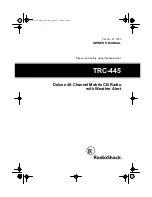
UNDERSTANDING SHORTWAVE BANDS
continued
E 1 0
O P E R A T I O N M A N U A L
27
26
N I G H T B A N D C H A R T
NIGHT
BANDS
25m
31m
41m
49m
CHARACTERISTICS
Similar to 31m
Good all night everywhere. Often extremely good at sunrise and sunset.
Good results often start about an hour before sunset.
Similar to 49m. Good all night in Eastern North America; varies in
Western North America.
The best overall night band.
EVENING/NIGHT LISTENING
This is the best time to listen, because the broadcasters are deliberately transmitting to North America.
These bands may be extremely good around sunset and sunrise too. Best night bands are shown in BOLD
print in the table below.
IF YOUR BUILDING BLOCKS SIGNALS:
If you notice that the signal strength of a stations
substantially improves when you get very close to a
window or when you go outside, then it is certain
that your building blocks shortwave signals. This
blockage is due to the construction materials of
your building or to having one or more stories or
levels above you. The solutions to this are to do
your listening very close to a window, to go outside
or to set up an outdoor shortwave antenna. For
ideas on how to set up an outdoor shortwave
antenna, use your favorite Internet search site and
type in ‘shortwave antennas’. If you don’t have
Internet access, contact us,
etón
Corporation, using
the contact methods noted at the beginning of this
manual.
UNDERSTANDING SHORTWAVE BANDS
continued
DAY
BANDS
13m
16m
19m
22m
25m
31m
CHARACTERISTICS
Results vary. Worth trying.
Sometimes extremely good around
sunrise and sunset.
Similar to 19m.
The best overall daytime band. May
also be good at night in the sum-
mer months. Sometimes extremely
good around sunrise and sunset.
Sometimes good at night in the
summer.
Similar to 19m.
Best around sunrise and sunset.
May be good mid-day in Eastern
North America.
Similar to 25m.
DAY BANDS AND NIGHT BANDS
THE DIFFERENCE IS IMPORTANT
Because shortwave signals depend on such factors
as the sun, the ionosphere and interaction with the
earth itself, signals cannot be heard on all bands
throughout the day. Some bands are best during
the daylight hours, and some are best at night. In
general, the bands with frequencies below 13 MHz
(13000 KHz) are better at night and the bands
with frequencies above 13 MHz (13000 KHz) are
best during the day. Listed below are the character-
istics of the major shortwave bands. Follow these
guidelines for best listening results. How to get into
a specific band will vary from one radio to another.
Consult your owner’s manual for instruction on
how to access the bands on your radio or call
etón
Corporation if it’s not clear to you.
SUNSET AND SUNRISE
OFTEN THE VERY BEST TIME TO LISTEN.
We are often asked whether there is a truly best
time for listening to shortwave, when signals are
strongest and clearest. Often, this is a window of
hours right around sunset and sunrise. Sometimes
it’s a two-hour window, other times three or four
hours. Experiment to determine when it’s best in
your area.
DAYTIME LISTENING
Shortwave listening is generally at its poorest dur-
ing the daylight hours of about 10 a.m. to 3 p.m.
The major reason for this is that the broadcasters
are not transmitting to North America at this time,
assuming that we are all either at work or at
school and are not able to listen during the day. If
you want to try daytime listening, use the guide-
lines below. Typically, daytime shortwave tends to
be better in Eastern North America than in Western
North America. The best daytime bands are shown
in BOLD print in the table below.















































